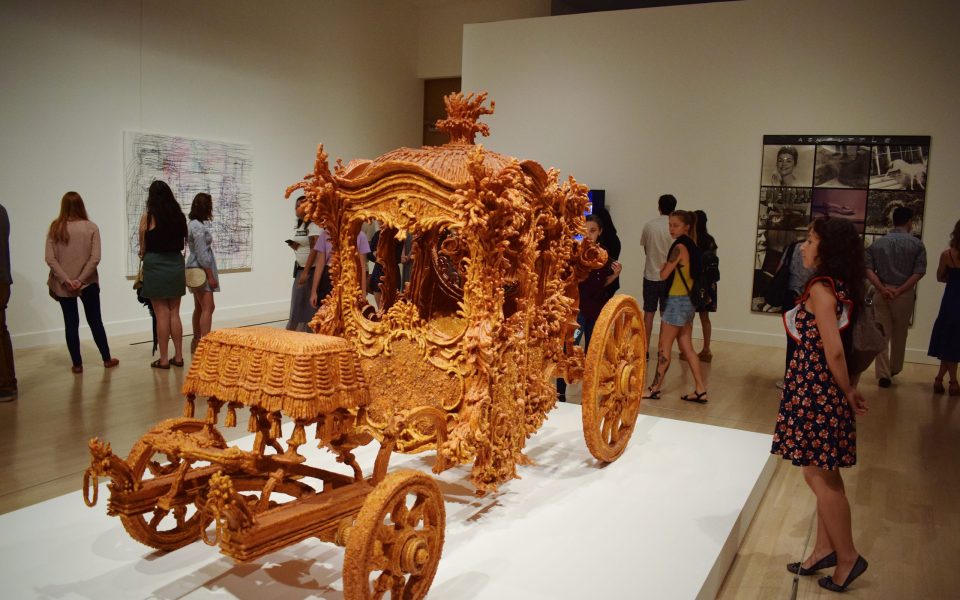Flaxen, braided hair tendrils — dozens of them, dreamlike and overwhelming — cascade from the high-ceilinged gallery as viewers stand in place of the witch or Rapunzel’s suitor. Cherry-red ribbons tied to the tendrils read “clean water,” “my family” and “free speech,” all rebukes to the witch’s misogynist emphasis on purity.
MK Guth’s “Ties of Protection and Safe Keeping” is but one sculpture featured in Dread & Delight: Fairy Tales in an Anxious World, a new exhibit of contemporary works rooted in the Brothers Grimm compilation of centuries-old fireside tales at UNCG’s Weatherspoon Art Museum. The exhibit, which invites all attendees to grapple with personal and cultural values, is on display through Dec. 9 in the Bob & Lissa Shelley McDowell Gallery.
Paintings, photographs, videography and sculptures focus a critical lens on familiar classical tales. Entrapment and exploitation of power are common motifs, whether manifested in Rapunzel’s imprisonment or the French telling of All Fur, in which the heroine faces incestuous threat.
With “Mother-Load,” Timothy Horn calls the rags-to-riches American dream into question in his life-size riff on Cinderella’s pumpkin-turned-carriage fashioned from polystyrene foam, crystallized candy and shellac. Not all that glitters is gold, after all. Maybe late capitalism and the farce of meritocracy are our cruel stepmothers.
Sculptor Tom Otterness also scrutinizes society’s ills in his bare-bones bronze construction, taking inspiration from Hansel and Gretel. Whereas Gretel isn’t caged in the classic story, both children are imprisoned here and it is Hansel who clings for comfort to the bars of a cubic cage, the frightened sibling. Their fate is less certain than in classic tellings because no one else is around; even the identical cage beside them is empty. What previous tenets have since perished? Who will occupy the cage next? Otterness’ Spartan sculpture coupled with the story’s underlying context of child abuse as linked to poverty tell the beholder a story about hunger, of malnutrition and yearning for childhoods filled fuller with play than fear.

©
Artists also contend with racial constructions of beauty. Carrie Mae Weems’ staged photograph “Mirror Mirror” is also one of few works in Dread and Delight to offer comic relief despite subject matter. The photograph is one in her series Ain’t Jokin, Weems’ project examining racial jokes. In it, a black woman holds a rectangular, framed mirror to her face above an all-caps, sans-serif font reading: “Looking into the mirror, the black woman asked, ‘Mirror, mirror on the wall, who’s the finest of them all?’ The mirror says, ‘Snow White you black b****, and don’t you forget it!!!.’” The quote is attributed to Jackie “Moms” Mabley, a civil rights-era black comedian who sought to lay bare the implicit racial bias in Walt Disney’s emergent franchise. The tarred female figure in Alison Saar’s hanging sculpture “Blonde Dreams” is elevated but, rather than confined to a pedestal (or tower, like Rapunzel), her feet are bound with rope from the ceiling and she is thus rendered immobile, her free-flowing gold-leafed hair dangling below her. The pose evokes a lynching, but the artist insists the suspension is self-inflicted, an attempt to achieve desirability under the terms and conditions of Eurocentric beauty standards.
Photographer Miwa Yanagi extends the conversation to ageism, namely the dynamic in which these tales position young and old women in diametric opposition, a binary of good and evil. Her black-and-white photograph shows a young woman taking a meagre, wrinkled finger into her mouth, an action simultaneously grotesque and alluring. The hand of this unseen witchy character emerges from columned bars, but who is captor here? Yanagi seems to suggest that ageism clutches both as captives.
Opening night last Saturday, museum-goers went swimming in the collective unconscious amongst eager, speculating art students, considering what, or whom, they’d consumed or locked up high in towers, not so innocent after all.
Join the First Amendment Society, a membership that goes directly to funding TCB‘s newsroom.
We believe that reporting can save the world.
The TCB First Amendment Society recognizes the vital role of a free, unfettered press with a bundling of local experiences designed to build community, and unique engagements with our newsroom that will help you understand, and shape, local journalism’s critical role in uplifting the people in our cities.
All revenue goes directly into the newsroom as reporters’ salaries and freelance commissions.


Leave a Reply